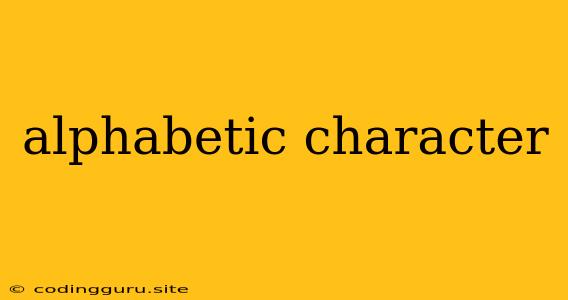Understanding Alphabetic Characters: A Guide to Letters and Their Role in Computing
The world of computing is built upon a foundation of symbols, and among these, alphabetic characters hold a prominent place. They form the building blocks of languages, enabling us to communicate, write code, and store information. But what exactly are alphabetic characters, and how do they function within the digital realm?
Alphabetic characters are the individual letters that make up alphabets. They are distinct from numerals, punctuation marks, and other symbols. Each character represents a unique sound or concept, allowing us to form words and convey meaning.
What Makes an Alphabetic Character "Alphabetic"?
The defining characteristic of an alphabetic character is its role within an alphabetical system. An alphabet is a set of symbols used to represent the sounds of a language. Each symbol in an alphabet, or alphabetic character, corresponds to a specific sound.
For example, the English alphabet consists of 26 alphabetic characters, from A to Z. Each letter represents a distinct sound, which, when combined with other letters, forms words.
The Importance of Alphabetic Characters in Computing
Alphabetic characters play a crucial role in various aspects of computing:
- Programming: Programming languages heavily rely on alphabetic characters to define variables, functions, and keywords.
- Text Processing: Word processors, text editors, and search engines use alphabetic characters to manipulate and understand text.
- Data Storage: Databases and file systems use alphabetic characters to organize and label data.
- User Interfaces: Alphabetic characters are used in menus, buttons, and other interface elements for user interaction.
Representing Alphabetic Characters Digitally
To be processed by computers, alphabetic characters need to be represented in a digital format. This is achieved using character encoding systems, such as ASCII (American Standard Code for Information Interchange) and Unicode. These systems assign a numerical value to each alphabetic character, enabling computers to understand and manipulate them.
Understanding Character Encoding
Consider the letter 'A'. In ASCII, it is represented by the decimal value 65. This numerical value is then converted into a binary sequence (01000001), which the computer can process.
Unicode is a more extensive encoding system that supports a wider range of characters from different languages. It provides a unique numerical value for each alphabetic character across various alphabets, including Latin, Greek, Cyrillic, and more.
Alphabetic Characters and Beyond
While alphabetic characters are fundamental to written communication, they are only one component of the broader world of computer symbols. Other characters like numerals, punctuation marks, and special symbols also play vital roles in computing.
Conclusion
Alphabetic characters are the foundation of written communication and a crucial element of the digital world. They enable us to express ourselves, create software, and store information. By understanding how these characters are represented and processed digitally, we gain a deeper appreciation for the intricate workings of computers and their role in our lives.
